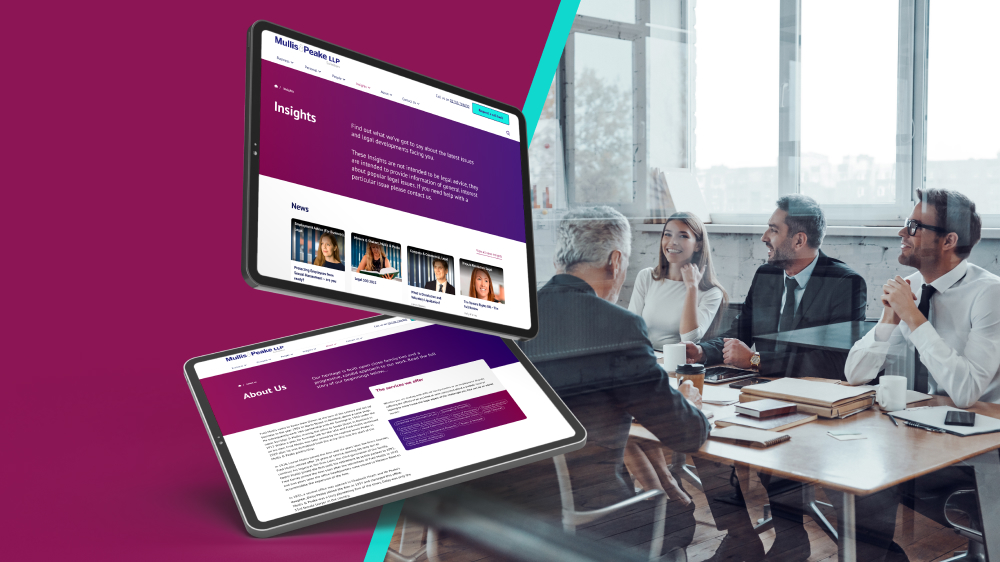Complete Guide to Law Firm Web Design
Your law firm’s website is more than just a digital business card — it’s a powerful tool for attracting clients, building trust and showcasing expertise. It’s also an essential tool for lead generation.

Luke is the Lead Designer at Itineris, specialising in creating compelling digital experiences that blend creativity with strategy. With a strong focus on lead conversions, he crafts user-centric designs that not only captivate but also drive results. His keen eye for detail and passion for innovation ensure brands stand out through engaging visuals and seamless interactions.
More than one in three potential clients start their journey looking for a law firm online. Before they ask a friend or family member for a referral, they’ll head straight to a search engine.
And with organic search dominating as the main source of website traffic for law firms (around 53%), you need a well-equipped, high-ranking website to succeed in this online environment.
After attracting potential clients, a well-designed law firm website makes a strong first impression. It guides visitors seamlessly to the information they need, and it’s the deciding factor on whether a prospect books a meeting with your firm.
Everything that goes into your website plays a role in ensuring your firm stands out online. So, you need to ensure your site ticks all the right boxes. This is where clever law firm web design is so important.
The Unique Challenges of Law Firm Web Design
Law firms have a few specific needs when it comes to web design. They need to balance professionalism, trust and accessibility while ensuring compliance with legal and regulatory guidelines.
A well-designed website attracts clients, builds credibility and supports case inquiries. But getting it right isn’t always straightforward.
Here are some factors to keep top of mind when planning your law firm web design.
Establishing Trust and Credibility
One of the biggest challenges for a law firm’s website is establishing trust.
Law is a profession built on credibility, and research shows that 81% of clients research a firm online before making contact. After that, people spend an average of only two minutes on a law firm’s website – that’s how quickly your potential clients will bounce off your site if you don’t make an immediately positive impression.
So, a trustworthy website is absolutely essential for generating law firm leads.
If a website looks outdated, lacks clear information or doesn’t showcase expertise, your potential clients will quickly look elsewhere.
To build trust, firms need to highlight their credentials, display professional photography rather than stock images and feature client testimonials or case outcomes. A modern, user-friendly design also helps reinforce credibility.
All this needs to be displayed and conveyed straight away, before prospects bounce after that two minute mark. Doing so will require instant trust signals ideally placed above the fold (so that prospects gain trust before needing to scroll).
So, make sure your homepage has all the trust signals needed to keep prospective clients engaged.
Clear Navigation and Structure
Navigation is a key issue for any website. Especially when it comes to law firm websites that specialise in various areas and offer a range of niche services.
Legal services can be complex, and clients often visit a firm’s website with a specific issue in mind, whether it’s family law, corporate contracts or personal injury claims. If they can’t quickly find what they need, they’ll leave and head to another website where this information is clearly laid out.
Law firm websites should always have a clear, intuitive structure that outlines practice areas in simple terms.
Contact details, FAQs and key resources should be easy to access, and mobile optimisation is essential, given that more than 50% of legal searches happen on mobile devices.
Quite simply, as we’ve already covered, if prospects can’t immediately find the information they’re after, they’ll bounce from your site in a matter of minutes (if not seconds). So, clear navigation and well structured content is vital.
When our team worked with Bristows, a law firm with complex areas of specialisation, we reduced their bounce rate by 22%. This largely came down to an enhanced site navigation and user experience, which made a complex website a lot more compelling and digestible.
Compliance and Legal Restrictions
Compliance is a major factor for any website, but law firms should pay extra attention here.
Law firms must follow strict advertising and data protection rules set by the Solicitors Regulation Authority (SRA) and the Bar Standards Board (BSB). Websites must avoid misleading claims, provide transparent pricing where required, and ensure that client data is handled securely in line with the latest GDPR regulations.
Accessibility is also crucial, as firms must ensure that content is readable and available to all users, including those with disabilities. Businesses need to ensure their sites meet WCAG 2.2 accessibility standards, which far too few actually do.
Failing to meet these legal requirements can lead to fines and reputational damage. Beyond this, a website with poor accessibility will chase away valuable traffic and potential clients.
Just take a look at our article on the importance and potential of accessibility, and you’ll see that an accessible site is so much more than just a website designed to meet certain standards or help a select few users.
Instead, by maintaining a high level of website accessibility, you make your site easier to navigate for everyone. This can improve SEO, increase conversions, reduce your bounce rate and enhance your overall digital experience.
In fact, an evidence-based study concluded there was a 12% average increase in overall search traffic for accessible websites, with 66.1% of domains seeing organic traffic growth of up to 50%.
Converting Visitors into Clients
Your law firm website isn’t just there to make your firm visible online – it’s there to convert visitors into clients.
After all, a great design is pointless if it doesn’t drive enquiries.
Clear calls to action, such as booking a consultation or calling your firm, are essential. Live chat options can improve conversion rates. Page speed is another crucial factor, as websites that take more than three seconds to load lose 40% of visitors.
It’s also important to understand that improving conversion rates is an ongoing process for any law firm.
Beyond the initial web design, you should be actively working on monitoring your website analytics and enhancing your site and landing pages to improve conversions and the user experience. This largely comes down to strategic data usage.
Get this right, and you’ll experience an ongoing improvement in not only traffic and engagement, but also in generating leads (and clients) for your firm.
Balancing Professionalism with Approachability
Many people seeking legal help feel anxious, and overly formal websites filled with legal jargon can make them feel alienated.
Firms should use plain English, publish helpful blog content that answers common legal questions and include video introductions from solicitors to make them more relatable.
A website that feels both professional and welcoming will be far more effective at engaging potential clients.
When it comes to blogging, you won’t only help users but also attract a lot more traffic. Firms that maintain a blog see 57% more visitors and generate 67% more leads. And if you frequently update this blog content, you can bring in 400% more traffic than firms with inactive blogs.
This is a massive opportunity for both generating traffic and engaging clients, as only 27% of law firms maintain a blog. So, this is an enormous content opportunity to capitalise on.
Standing Out in a Competitive Landscape
While it’s important that your firm and site is approachable and easy to navigate, it’s also important that you show absolute expertise in your area of specialisation.
As the law firm market can be seriously crowded, many firms go deep instead of wide to attract more clients. If your firm does the same, and specialises in a specific sector, then you’ll want to make this specialised knowledge known.
Showing expertise in your sector means more than just stating it. Your website should demonstrate it through in-depth insights, case studies and thought leadership content that speaks directly to your audience’s challenges.
A well-crafted site not only showcases your firm’s experience but also builds trust, making it clear why clients should choose you over competitors.

Key Elements of a Successful Law Firm Website
A well-designed law firm website does more than just look good — it builds trust, attracts new clients and ensures smooth interactions.
While there’s a lot that goes into this, law firms need to focus on three key areas to get it right: client experience, branding and technical performance.
A Client-Centred Experience
First and foremost, a successful law firm website is designed with potential clients in mind.
Yes, you need your site to be search engine-optimised, but don’t build your site with only search engines in mind. Think about your clients first.
Visitors will arrive on your website with a legal problem and need clear, easy-to-understand information. If your site is filled with legal jargon or long-winded explanations, they’ll leave before making contact. If you don’t address their needs directly, they’ll leave.
Good copywriting plays a crucial role in keeping things simple.
Studies show that readers typically leave a webpage within 15 seconds if they don’t find what they need. This means law firms must clearly outline their services, explain how they can help and provide a straightforward way for clients to take the next step.
As we’ve already mentioned, a confusing website structure will frustrate visitors and drive them to competitors. A well-organised site should have intuitive menus, clearly labelled pages and a logical flow that guides users towards the important information they’re after.
Contact details should always be easy to find, with multiple ways to get in touch.
For firms looking to enhance their client experience further, online client onboarding can be a game-changer. This allows potential clients to submit initial details through secure intake forms to speed up the process and improve convenience.
When we worked with Farrer & Co, a well-established and respected legal firm, a big part of the challenge was taking a traditional client approach (largely built on referrals) and modernising this to compete in the digital space. Amongst other things, a client-centred digital experience helped the firm reduce their bounce rate by 32%.
Strong Branding and Authority
A law firm’s website must reflect its brand and reputation.
First up, poor-quality visuals, generic messaging or a lack of personality will make any firm seem untrustworthy or unremarkable straight away. As soon as visitors land on your site, they need to be hit with absolute professionalism.
High-quality imagery is essential. Avoiding stock photos. Instead, using professional headshots of solicitors helps create a stronger connection with potential clients.
A well-crafted ‘About Us’ page should introduce the team, highlight their expertise and communicate your firm’s values and mission.
Social proof is another vital branding element.
84% of people trust online reviews as much as personal recommendations. So, including testimonials, case studies and positive client feedback on your website will help establish credibility.
Displaying memberships with professional bodies, such as the Law Society or the SRA, will also reassure visitors that your firm is reputable.
Publishing authoritative content is another way to build trust. Regularly updating a blog with legal insights, FAQs or case studies demonstrates expertise and helps potential clients feel informed before they even reach out.
Some of the most successful law firm websites feature videos of solicitors explaining legal topics in simple terms, making the firm appear more approachable.
Remember, clients might discover your firm online, but they still want to feel a connection to your team and what you offer. So, ensure the human element, which is so important when working with a legal firm, is present on your website.
Technical Performance and SEO
A visually appealing, user-friendly website is only effective if people can find it. This is where technical performance and law firm SEO come in.
As we’ve already mentioned, fast loading times are essential. Law firm websites should be optimised for speed by compressing images, minimising unnecessary scripts and using reliable hosting services.
Again, we can’t stress the importance of website accessibility. Websites should be designed so that everyone can navigate them easily.
This means using readable fonts, strong colour contrasts and ensuring the site works with screen readers. Law firms that fail to meet accessibility standards not only risk losing potential clients but could also face legal consequences.
Mobile-friendliness is equally important. With around half of legal-related searches happening on mobile devices, a site that doesn’t work well on smaller screens will turn away potential clients.
Pages should resize properly, buttons should be easy to tap and contact forms should be simple to fill out on a smartphone.
A well-optimised law firm website should appear in search results when potential clients look for legal help in their area. This involves using relevant keywords, structuring content for readability and ensuring each page has a clear purpose.
Firms that invest in SEO often see a significant increase in website traffic and client enquiries over time.
Although, SEO is a big topic – especially when it comes to law firms that offer localised services.

Creating Enough Relevant Service and Landing Pages for Your Law Firm Website
To attract and convert the right clients, law firm websites must include dedicated service and landing pages tailored to specific legal needs. These pages help potential clients find the right information quickly and improve your firm’s visibility in search engines.
Each practice area should have its own detailed service page. Instead of a single “Legal Services” page, create separate pages for areas like Family Law, Employment Law, Corporate Law and Litigation.
This makes it easier for clients to understand your expertise and improves search rankings. Law firm websites with well-structured service pages typically see higher engagement rates and more direct enquiries.
Landing pages are equally important for marketing campaigns and location-based searches. If your firm operates in multiple cities, create location-specific pages, such as “Divorce Solicitors in London” or “Employment Lawyers in Manchester.”
These pages help capture local search traffic and provide a more personalised user experience.
By structuring your website with enough relevant service and landing pages, you make it easier for clients to find what they need while improving your SEO performance.
Relevant service pages are also important for displaying your expertise (as we outlined above). With dedicated pages for your areas of knowledge, law firms can better attract and engage potential clients.
Law Firm Website CMS and Hosting Considerations
Beyond web design, choosing the right CMS (Content Management System) and hosting solution is crucial for a law firm’s digital success.
A law firm website needs to be secure, scalable and easy to manage. WordPress VIP is an ideal choice for enterprise law firms, offering high performance, top-tier security and flexibility to meet complex content needs.
It allows firms to easily update content, publish legal insights and integrate with essential tools like CRM systems.
Scalability is also a key factor. Law firm websites often need to handle large amounts of traffic, especially during high-profile cases or marketing campaigns.
A slow or unreliable website can damage credibility and drive potential clients away.
Beyond just the website, a law firm’s CMS and hosting choice impact its broader digital strategy.
A well-optimised site supports SEO, integrates seamlessly with marketing tools, and enhances client engagement.
Firms investing in a powerful CMS and secure hosting aren’t just building a website — they’re creating a digital platform that drives business growth and strengthens their reputation online.

Law Firm Web Design Examples
All that said, let’s take a look at some examples of effective law firm web design projects.
Here are a few of the law firms that we’ve worked with at Itineris. While each project was different, they all involved optimised websites with streamlined and accessible user journeys. In all of the cases, the updated web designs helped the legal firms increase their reach, engagement and online success.
Click on the links below to explore the websites.
Bristows

Farrer & Co

Mullis & Peake

HFW

Work With the Right Law Firm Web Design Agency
A well-designed law firm website is a vital asset, not just a necessity. It should be clear, engaging and built to convert visitors into clients. By focusing on the right areas, your firm can create a site that builds trust and drives enquiries. Investing in the right CMS, hosting and SEO strategy ensures long-term success.
Ultimately, you need to work with a web design agency that understands the unique challenges law firms face and knows how to address them. That’s where we can help.
At Itineris, we’ve got over 23 years of experience working with top law firms. Get in touch with us to see how we can help build and improve on your digital presence.




